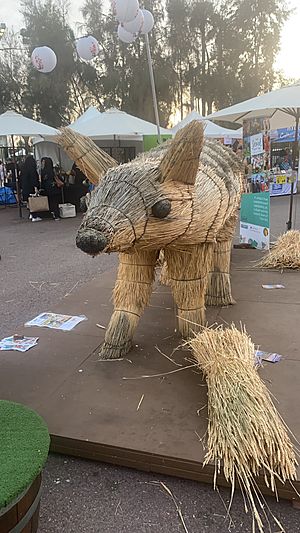Wara art facts for kids
Wara art is a special Japanese art form where people create huge sculptures using rice straw.
What is Wara Art?
For a long time, people in Japan used rice straw to make things like tatami mats (which are special floor mats) and other useful items. But as new materials were invented, less and less rice straw was needed. This left rice farmers with a lot of leftover straw.
In 2007, farmers in Niigata Prefecture, Japan, which is a big area for growing rice, had an idea. They asked Professor Shingo Miyajima from Musashino University to help them find a creative way to use the extra straw.
Professor Miyajima suggested turning the straw into large sculptures, especially of animals. These sculptures are built around a strong wooden frame. In Japan, this art is called "wara art," because "wara" is the Japanese word for rice straw.
Since 2007, there have been yearly wara art festivals in the Nishikan-ku area of Niigata prefecture. Some of these amazing straw statues have been as tall as 9 metres (about 30 feet)! Most of them are around 4 metres (about 13 feet) tall.
Wara Art in Australia
Wara art has also traveled all the way to York, Western Australia. Here, sculptures of Australian animals that are in danger of extinction have been created. Professor Miyajima designed these sculptures.
There are seven wara art statues in York. They were built by artists from Australia and Japan, who came together as part of art exchange programs. Many volunteers also helped. Since there isn't much rice straw in Western Australia, the sculptures in York are made from wheat straw. This straw comes from a local farm that still gathers its wheat in traditional bundles called stooks.


